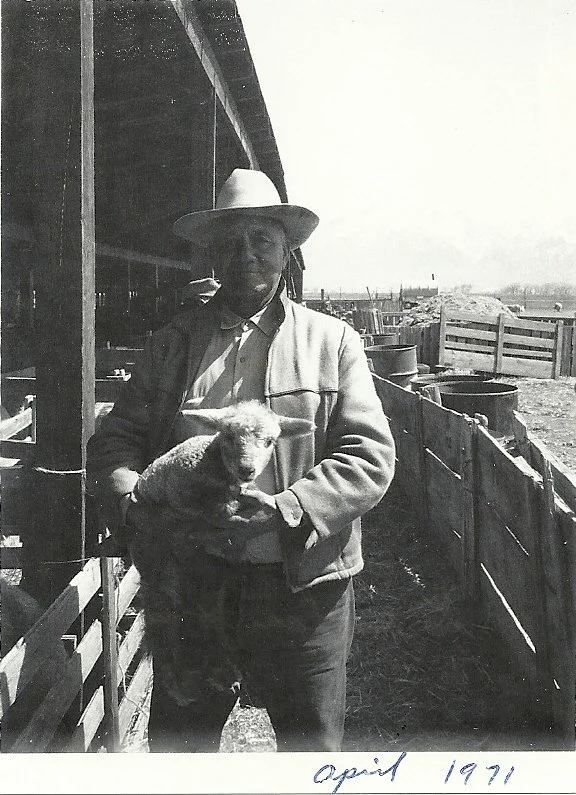Eph Jensen, 1971
Eph Jensen Livestock is a family owned and operated range sheep outfit based just outside Bear River City, Utah. Eph Jensen (1894-1987), the son of Danish immigrants, began herding sheep for a cousin after serving in World War I. He started purchasing land for his own sheep operation in 1928, and by 1945 was running his own herd of 1,200 ewes. Eph’s son Karl Jensen returned to work the ranch after graduating from the University of Utah in 1958.
Now run by Karl’s son Lane, Eph Jensen Livestock today pastures 2,200 sheep on native ranges in Box Elder, Cache, Weber, Wasatch, and Duchesne Counties. Most notably, the Jensens are the only sheep outfit that still trails their ewes home each fall via a dedicated right of way on a historic sheep trail that runs down Box Elder Canyon and through Brigham City. This 2-day, 23 mile migration takes place every fall on the third Friday & Saturday of October.
That the Sheep May Safely Trail
A portrait by Carolyn Jensen Parker, written in 2003
The trailing-the-sheep tradition that you see today had its beginning more than 60 years ago. Since the late 1930s, 1600 or more ewes of a sheep-raising operation begun by Eph C. Jensen, continued by his sons Karl and Reed Jensen, and now carried on by Karl’s son, Lane, have trailed through Brigham City. The ewes are headed from their summer pastures high in the hills of Cache and Weber Counties to their winter range on Little Mountain and other parts of Box Elder County. When the tingling green leaves atop the white-barked aspens turn gold, the ewes know it is time to leave the grazing ranges of summer.
Livestock trails and rights remain as part of the old West way. When Eph Jensen trailed his first band of ewes down from their summer range, there were a dozen or more herds following this same route. Some oldtimers say nearly 30,000 sheep grazed and grew in Box Elder County back then. Today, only a few herds will use this trail.
For the Jensen herd, the trailing home tradition takes two days. The first day is easy; the ewes shortcut up Three Mile, across a high country pass, and enter Mantua from the Rocky Dugway—an 11-mile trek, all far from traveled roads. The riskiest part of the trip starts off day two when the 1,600 ewes trail down Box Elder Canyon, sharing road space with speeding cars and 18-wheelers. Side by side the sheep and modern machines snake down the canyon. The Peruvian herder and third generation Jensen family members act as herders-for-a-day and on horseback and afoot push the herd to the highway’s edge. Behind the herd comes the truck-drawn sheepcamp, a compact model of isolated life that one Western writer called “a child of the prairie schooner.” Finally, a most-welcome and much appreciated sheriff’s patrol car, lights flashing, alerts traffic to slow down.
When the trailing sheep enter Brigham, they head north on 600 East. Sixty years ago this street was on the fringe of town, unpaved and lined with peach orchards. Today, it becomes an impromptu parade route. Floats and waving public officials are replaced by a moving mass of wool, sounds of a lone sheep bell, hooves hitting asphalt, and a wide-range of baas. The truck pulling the sheepcamp comes last and now carries the barking border collies; their instinct to herd makes them too vulnerable to traffic dangers. The herd will head out of Brigham along 600 North, traveling west and then north, finally crossing the Bear River to reach ther evening passture about 22 miles from where their day began. Every ewe in the herd knows her way. Try to change that route and the sheep balk. Should a ewe be left behind in the hills, she can find her way home.
As you watch you know this is not an everyday event. In many places in the West the trailing tradition is already only an oldtimer’s memory. Sheep ranchers have sold out or gone broke—signs of an unfriendly economy. Some truck their herds. The trails, maintained by annual use, grow dim. Perhaps a time will come when sheep no longer trail home. More than the trails would then be lost.
